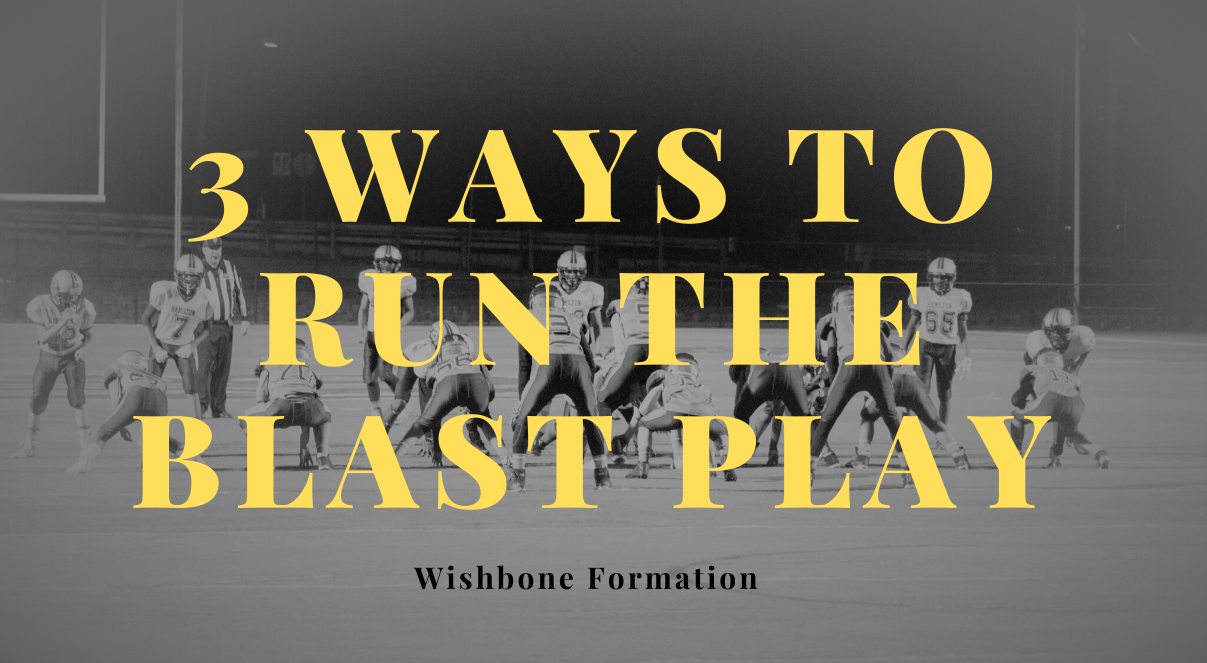3 Different Ways to Run the Blast Football Play | Wishbone Formation

The Blast Football Play is on of the best plays in all of football. It’s a play that works very well on all levels of football. It’s easy to install and the double Tight-end formation will force the defense to stay balanced and respect both sides of the formation. The Blast Play typically is executed out the Wishbone formation, it’s an off-tackle play that has two lead blockers. Here are 3 different ways you can block Blast football play.
3 Ways to Run the Blast Football Play out of the Wishbone Formation
(1) Blast Base Blocking
Center: Block head up nose guard. If the center is seeing double A-gap defenders he is to block the backside A-gap defender. Backside meaning the defenders opposite of the play-side.
Right Guard: Inside-Over-Free blocking rules.
Right Tackle: Inside-Over-Free blocking rules.
Left Guard: Inside-Over-Free blocking rules.
Left Tackle: Inside-Over-Free blocking rules.
Tight-end (RT): Base defensive end out. The TE must secure his inside gap first- if he has a defender head up or on his inside shade he needs to block him and the lead back takes the DE.
Tight-end (LT): Step play-side, cutoff linebacker pursuing to the ball carrier.
Quarterback (1): Take snap, handoff to the 3 coming off-tackle. It is the QB’s job to get the football to the 3, the 3 should never alter his path to get the football.
Fullback (2): Lead block, look to block the middle linebacker. The 2’s blocking path is inside to out. He must plug any interior defensive line penetration.
Halfback (3): Take handoff, look to cut off of the 3’s lead block. He must stay on his path and not go to the QB for the handoff.
Halfback (4): Lead block, look to block the outside linebacker. If the TE has an inside gap defender the TE will block him and now the 3 will take the DE or OLB (depending on the defense).
Related Content: Inverted Wishbone QB Trap Play
(2) Blast Play with Belly Blocking (Gap-Down-Backer)
Center: Block head up nose guard. If the center is seeing double A-gap defenders he is to block the backside A-gap defender. Backside meaning the defenders opposite of the play-side.
Right Guard: Pull, kick-out the defensive end. If it is an even front, the RG will kick-out the OLB. The aiming point is the inside hip of the defender he is kicking out. Kick-out path should be right off of the butt of the down blockers (RT & TE). No flat pull paths!!
Right Tackle: Gap-Down-Backer.
Left Guard: Inside-Over-Free.
Left Tackle: Inside-Over-Free.
Tight-end (RT): Gap-Down-Backer.
Tight-end (LT): Step play-side, cutoff (linebacker pursuing to the ball carrier).
Quarterback (1): Take snap, handoff to the 3 coming off-tackle. It is the QB’s job to get the football to the 3, the 3 should never alter his path to get the football.
Fullback (2): Lead block, look to block the middle linebacker. The 2’s blocking path is inside to out. He must plug any interior defensive line penetration.
Halfback (3): Take handoff, look to cut off of the 2 & 3’s lead block.
Halfback (4): Lead block, look to block the outside linebacker. If the TE has an inside gap defender the TE will block him and now the 3 will take the DE or OLB (depending on the defense).
Related Content: Wishbone Playbook for Youth Football
Blast Play- Unbalanced Formation (tackle-over)
Going Tackle-Over will give you an extra blocker at the point of attack. Tackle-over RT will tell the LT to come over to the right side. This will get you both of your best linemen on the play-side blocking for your RBs. It will also give the defense an extra gap to account for. What’s great about the Tackle-Over Wishbone Formation is that if the defense does over-shift to the strength you can run Blast to the weak side and still have several blockers at the point of attack. Also, if you decide to go unbalanced, make sure your players get set and run the play fast- do not give the defense time to recognize and adjust.
Center: Double team the nose with the RG. If the center has double A-gap defenders the center is to block the backside A-gap defender and the RG blocks down on the play-side A-gap defender.
Right Guard: Hip to hip with the center, double team the nose. Drive the kid into the end zone.
Right Tackle: Double team the defensive tackle with the LT. Hip to hip and drive the DT into the end zone.
Left Guard: Inside-Over-Free.
Left Tackle: Double team the DT with the right tackle. Drive the defender into the end zone!
Tight-end (RT): Base out the defensive end. If the TE has an inside gap defender he blocks him.
Tight-end (LT): Step play-side, cutoff (linebacker pursuing to the ball carrier).
Quarterback (1): Take snap, handoff to the 3 coming off-tackle. It is the QB’s job to get the football to the 3, the 3 should never alter his path to get the football.
Fullback (2): Lead block, look to block the middle linebacker. The 2’s blocking path is inside to out. He must plug any interior defensive line penetration.
Halfback (3): Take handoff, look to cut off of the 2 & 3’s lead block.
Halfback (4): Lead block, look to block the outside linebacker. If the TE has an inside gap defender the TE will block him and now the 3 will take the DE or OLB (depending on the defense).
Here’s the Blast Play out of the T Formation which is very similar to the Wishbone.
Coaching Points
- It is the QB’s job to get the ball to the ball carrier in the backfield and at the point of attack. We want the QB to get the ball to the ball carrier in the backfield so that if there is penetration, the ball carrier can change his path to avoid running into a wall.
- You can easily utilize double teams across the board on the play-side.
- This is a fast hitting, downhill play. Make sure your backs get downhill and hit the hole.
- Lead blockers need to keep their eyes on their assigned defenders and not slow down or look back and clog the hole.
- Lead blockers must make contact and drive through the block.












